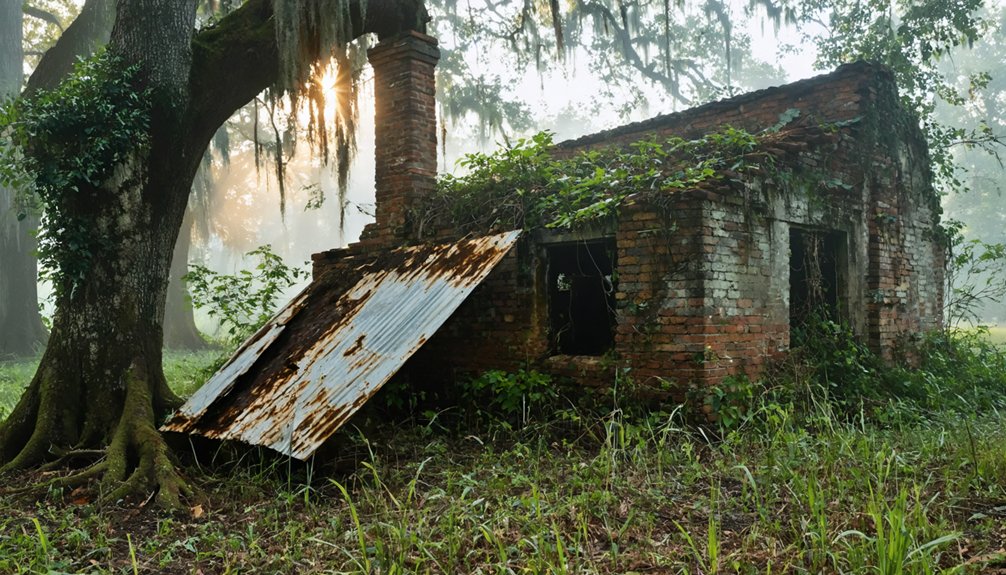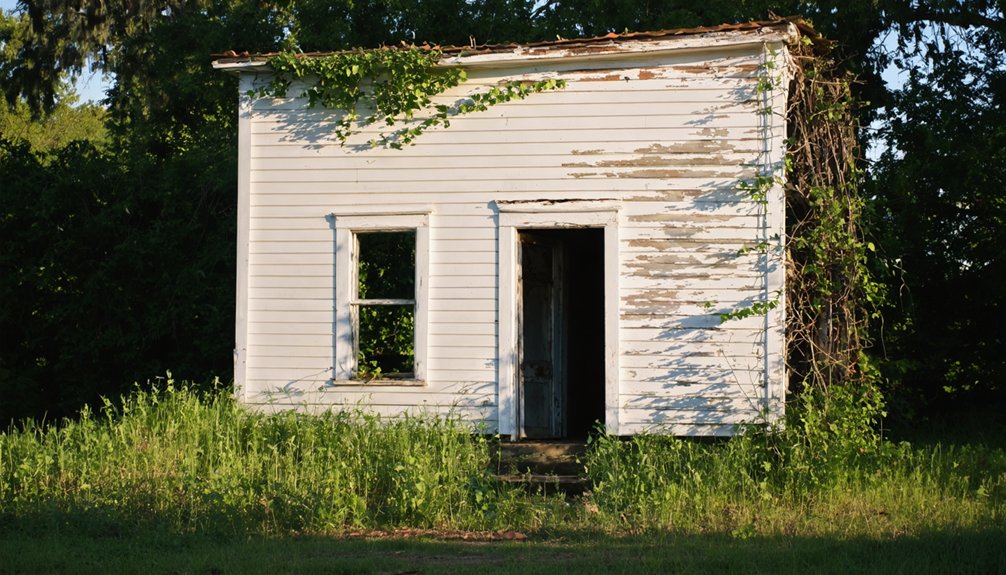You’ll find the ghostly remains of Fowltown, a former Mikasuki Seminole settlement, near present-day Bainbridge in Decatur County, Georgia. This strategic stronghold, led by Chief Neamathla, flourished until 1817 when U.S. forces burned it during the First Seminole War. While the exact location remains a mystery, historical markers now guide visitors to where this Native American community once thrived along the Flint River. The site’s complex story of resistance and sovereignty still echoes through Georgia’s borderlands.
Key Takeaways
- Fowltown was a Native American settlement near the Flint River that became abandoned after U.S. forces burned it in 1817.
- The exact location of original Fowltown remains unknown today, with only historical markers indicating its general vicinity near Bainbridge, Georgia.
- After its destruction during the First Seminole War, Chief Neamathla and Fowltown’s residents fled to Spanish Florida.
- Archaeological evidence, including broken millstones and ceramics, suggests past settlement but cannot definitively identify Fowltown’s precise location.
- Modern development and natural changes have obscured physical remnants, making Fowltown a ghost town known primarily through historical documentation.
Origins of the Seminole Settlement
While tensions simmered along the Georgia-Spanish Florida border in the early 1800s, the Mikasuki settlement of Fowltown emerged as a significant Native American stronghold under Chief Neamathla‘s leadership.
You’ll find that Fowltown’s story reflects the fierce cultural autonomy of its people, who established their community about 15 miles east of Fort Scott near the Flint River.
The settlement’s Mikasuki identity set it apart from the Creek confederacy, as its inhabitants rejected the Treaty of Fort Jackson and claimed sovereign rights to their territory.
By 1813, the settlement had grown substantially from its modest beginnings, with its population reaching several hundred.
You’ll discover that Fowltown wasn’t just a Native American settlement – it became a multicultural haven where Black Seminoles, free African Americans, and runaway slaves found refuge, creating a unique community that stood defiantly against U.S. expansion into their lands.
The village served as a thriving economic center with cattle and crops sustaining its diverse population.
Life in Early Fowltown
Life in early Fowltown centered around the strategic waterways of Georgia’s Flint River and its surrounding swamps, where Chief Neamathla’s band of Mikasuki people built a thriving community.
You’d find daily activities revolving around the rich resources provided by the river ecosystem, with villagers fishing the waters, hunting game, and gathering native plants from the swamplands. The Treaty of Jackson created tensions over land sovereignty that would ultimately impact village life. Inside Chief Neamathla’s home, a British uniform coat and certificate of loyalty revealed the tribe’s strategic allegiances.
Communal living defined the settlement’s character as families worked together to grow corn in nearby plots and construct dwellings adapted to the humid environment.
The village’s population swelled from 59 people in 1799 to several hundred by 1813, strengthening their self-sufficient lifestyle.
You’d see a well-organized community connected to neighboring groups through native trails, maintaining their independence through trade while preserving their cultural traditions.
The Path to Conflict
Following the Treaty of Fort Jackson in 1814, tensions escalated dramatically between U.S. authorities and the Seminole people of Fowltown. The treaty ceded vast Creek territories to the United States, but Seminole resistance emerged as Chief Neamathla disputed its implications for his people, who hadn’t participated in the Creek War.
You’ll find that treaty implications reached a breaking point when U.S. officials demanded the Seminoles abandon their village. Neamathla firmly rejected these demands, asserting Seminole sovereignty and independence from Creek obligations. The village had previously strengthened its position through British alliance during the War of 1812. The Seminoles were part of a growing confederacy of clans that had migrated from various southwestern tribes into the region.
In response, General Edmund P. Gaines ordered Major Twiggs to lead 250 soldiers from Fort Scott to forcibly remove the Seminoles. This military preparation culminated in a November 1817 skirmish, where U.S. forces burned Fowltown and sparked sustained fighting that would mark the beginning of broader conflict.
Battle and Abandonment
You’ll find the first shots of the First Seminole War exchanged at Fowltown when Major David E. Twiggs led 250 men against Chief Neamathla‘s village on November 21, 1817, resulting in five Seminole casualties.
Located three miles south of present-day Bainbridge, Georgia, the exact site of this historic village remains unidentified today.
The conflict escalated two days later as Lieutenant Colonel Matthew Arbuckle’s forces engaged in a fierce battle with Seminole warriors who emerged from nearby woods, leading to ten additional Seminole losses and one U.S. soldier killed.
After these clashes, the Seminoles abandoned their settlement, retreating into the surrounding swamps and leaving Fowltown to fade into history as one of Georgia’s ghost towns.
Like the town of Palmyra, which succumbed to the growth of nearby Albany’s industrial center, Fowltown’s population dispersed and never returned to rebuild.
Military Clash Ignites War
In late November 1817, tensions between U.S. forces and Seminole natives erupted into violence at Fowltown, igniting what would become the First Seminole War. The conflict began when Chief Neamathla refused to abandon lands his Mikasuki people had long inhabited, defying U.S. demands based on the Treaty of Fort Jackson.
You’ll find that Major David E. Twiggs led 250 soldiers in a pre-dawn assault on the village, but alert Seminole defenders spotted them first.
Though the initial skirmish lasted only 30 minutes, fighting continued for three days as warriors launched surprise counterattacks from nearby swamps. A letter discovered in Neamathla’s abandoned home revealed British ties, further intensifying American suspicions. Dr. Joe Knetsch, a noted authority on the Seminole War, has extensively documented these events.
U.S. forces ultimately burned Fowltown, forcing its residents to flee south into Spanish Florida.
This clash sparked broader Seminole resistance and marked a significant turning point in the struggle for Seminole sovereignty.
Village Defense and Retreat
When Chief Neamathla’s warriors spotted approaching U.S. forces in November 1817, they quickly implemented defensive tactics that would define the Battle of Fowltown.
You’ll find that the Mikasuki warriors first opened fire to protect their women and children, using the surrounding swamps and woods as natural cover.
During the second engagement, Neamathla’s forces emerged from hiding to launch a surprise attack on U.S. troops, demonstrating their mastery of guerrilla warfare.
Despite their effective resistance, the overwhelming American military presence forced the Mikasuki to make a strategic retreat.
They’d eventually re-establish their village further south in Spanish Florida.
The battle’s outcome marked a turning point, as you’ll see the loss of Fowltown became a catalyst for the First Seminole War.
Settlement Becomes Ghost Town
The U.S. military assault on Fowltown began on November 21, 1817, as Major David E. Twiggs led 250 men to capture Chief Neamathla and forcibly remove the inhabitants.
After the initial skirmish left five Seminoles dead, including one woman, a larger force under Lieutenant Colonel Arbuckle arrived to destroy the settlement.
You’ll find no physical remnants of the original Fowltown today, as the village was completely abandoned following the battle.
After a fierce 20-minute engagement on November 23, Neamathla and his people retreated into the swamps before relocating to Spanish Florida.
While historical preservation efforts continue, the exact location remains unidentified in present-day Decatur County.
Community engagement through historical markers helps keep the memory alive of this pivotal site where the First Seminole War began.
Geographic Features and Strategic Location
Situated at an essential junction of major waterways, Fowltown occupied prime territory near the confluence of the Flint and Chattahoochee Rivers in southwest Georgia. Its geographic significance extended to nearby Fowltown Creek, which fed into Kinchafoonee Creek, creating a network of strategic waterways that provided fresh water, transportation, and defense.
You’ll find the settlement’s original location strategically positioned on the southeastern bank of the Flint River, where rich soil supported agriculture and trade.
The terrain featured varied elevations, waterfalls, and swampy areas that offered natural protection. The land’s proximity to multiple water sources made it ideal for powering mills and sustaining the community, while its position near contested borders made it a critical military stronghold during conflicts between Native Americans and U.S. forces.
Legacy and Historical Significance

As a pivotal turning point in Native American relations, Fowltown’s destruction in 1817 sparked the First Seminole War and exemplified U.S. expansion policies in the Southeast.
The site’s legacy lives on through historical markers near Bainbridge, Georgia, and in the cultural resilience of Mikasuki and Seminole communities who preserved their accounts of the conflict.
You’ll find the battle’s significance reflected in multiple historical narratives.
The Mikasuki’s letter to the Bahamas’ Governor documented their traumatic displacement, while former Georgia Governor Mitchell’s reports confirmed Fowltown as the war’s catalyst.
Though the exact location remains unknown, the conflict’s impact resonates through generations, symbolizing both Native American resistance and the broader struggle for sovereignty in the face of territorial expansion.
Archaeological Mysteries
Despite numerous historic markers in Decatur County, you won’t find the exact location of the original Fowltown village, as multiple relocations by the Mikasuki people have complicated archaeological identification efforts.
You’ll notice broken millstones near the falls on Kinchafoonee Creek, suggesting industrial activity that once existed alongside the settlement.
While archaeologists have recovered ceramic fragments and trade goods consistent with Creek and Seminole habitation throughout the region, they haven’t definitively linked any artifacts specifically to Fowltown.
Site Location Remains Unknown
Where exactly did the historic Creek settlement of Fowltown stand? You’ll find this question remains one of the Southeast’s most intriguing site challenges.
While historical records place the largest settlement along the Flint River‘s southeastern bank near its confluence with the Chattahoochee in modern Decatur County, Georgia, multiple relocations have complicated precise identification.
Historical discrepancies further muddy the waters, as Neamathla’s band underwent at least four forced moves, establishing different Fowltown settlements over a brief period.
You won’t find definitive archaeological evidence either – few excavations have revealed conclusive settlement structures.
Modern development, reforestation, and natural landscape changes have obscured potential remains, while flooding and agricultural activities have altered original terrain.
Even Georgia Route 97’s historical markers can only approximate Fowltown’s vicinity.
Artifact Discoveries Near Creeks
The archaeological record near Georgia’s creek systems offers tantalizing clues about Fowltown’s material culture, though direct evidence remains sparse.
You’ll find that nearby Creek and Seminole sites reveal artifact significance through discoveries of ceramics, pipes, and tools that likely mirror what existed in Fowltown. At creek-side locations throughout the region, archaeologists have uncovered Wolfskin-phase bowls and distinctive bird-head pipes.
While European artifacts are remarkably scarce at Lamar-period farmsteads near waterways, creek discoveries have yielded fascinating ritual items and burial caches containing fragmented bones and miniature pots.
These findings paint a picture of indigenous communities maintaining their traditions despite growing colonial pressures. Though Fowltown’s exact location remains unknown, these regional patterns suggest a rich material culture that thrived along Georgia’s waterways.
Modern Day Remnants and Remembrance

Modern visitors to Decatur County who seek remnants of Fowltown will find historical markers rather than physical structures, as the exact location of this significant Seminole village remains unidentified.
Today’s historical preservation efforts focus on commemorating this pivotal site through community engagement and educational initiatives.
Historical groups keep Fowltown’s memory alive through local programs that educate and involve the community in preserving this crucial heritage site.
- Local historical societies organize guided tours highlighting Fowltown’s role in sparking the First Seminole War
- The area, approximately 3-4 miles south of modern Bainbridge, continues to draw history enthusiasts seeking to understand the region’s complex past
- Online resources and published materials help preserve the story of Chief Neamathla’s resistance and the village’s significance
While the physical town may be lost to time, Fowltown’s legacy endures as a symbol of indigenous sovereignty and the struggle for territorial rights in early American history.
Frequently Asked Questions
What Crops Did the Seminoles Primarily Cultivate in Fowltown?
As resilient as their spirit, you’ll find Seminole agriculture centered on the Three Sisters – corn, beans, and squash – while they’d also cultivate tobacco, melons, and gourds for sustenance and trade.
How Many People Lived in Fowltown During Its Peak Population?
You’ll find that Fowltown’s demographics reached their peak around 450 people in 1813, when the Mikasuki population, linked to Seminole history, thrived there before military conflicts forced their evacuation.
What Became of Chief Neamathla After Fleeing Fowltown?
You’d be amazed that after fleeing Fowltown, the mighty Neamathla refused a tiny reservation, returned to Hitchiti Creek lands, led resistance until 1836, and died in Oklahoma following the Trail of Tears.
Were There Any Trading Relationships Between Fowltown and Neighboring Settlements?
You’ll find limited evidence of specific trade routes between Fowltown and neighboring tribes, though their location near Spanish Florida and previous British alliances suggest some economic interactions likely existed.
Did Any Seminole Families Return to the Fowltown Area After 1818?
Despite hopes for Seminole return, you won’t find evidence of Fowltown families coming back after 1818. U.S. military pressure, hostile settlers, and the Treaty of Moultrie Creek made resettlement impossible.
References
- https://www.hmdb.org/m.asp?m=117158
- http://southernhistory.blogspot.com/2012/07/battle-of-fowltown-decatur-county.html
- https://en.wikipedia.org/wiki/Battle_of_Fowltown
- https://albanyherald.com/news/local/little-known-ghost-town-exists-right-up-the-road-from-albany/
- https://southwestgeorgia.com/bainbridge/history_ChasonMarkers.shtml
- https://www.exploresouthernhistory.com/fowltown.html
- https://www.youtube.com/watch?v=on_vwQ1T0ds
- https://seminoletribune.org/twice-unsuccessful/
- https://www.britannica.com/event/First-Seminole-War
- https://twoegg.blogspot.com/2019/11/fowltown.html



